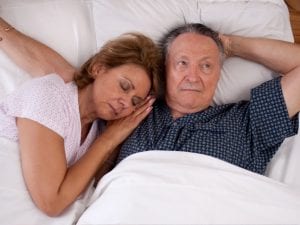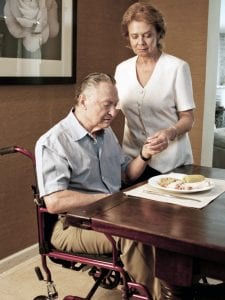Welcome to the educational program Sleep Issues: Managing Hallucinations, Illusions, Delusions, Nightmares, Sundowning, Anxiety, and Depression. This program will discuss how these issues can affect sleep and present some strategies for managing them.
. . .
This is Lesson 10 of The Alzheimer’s Caregiver. You may view the topics in order as presented, or click on any topic listed in the main menu to be taken to that section.
We hope that you enjoy this program and find it useful in helping both yourself and those you care for. There are no easy answers when it comes to the care of another, as every situation and person is different. In addition, every caregiver comes with different experiences, skills and attitudes about caregiving. Our hope is to offer you useful information and guidelines for caring for someone with dementia, but these guidelines will need to be adjusted to suit your own individual needs. Remember that your life experiences, your compassion and your inventiveness will go a long way toward enabling you to provide quality care.
Let’s get started.
Prefer to listen to this lesson? Click the Play button below to begin.
Alzheimer’s and Sleep
Sleeping through the night can be difficult for people with Alzheimer’s disease and other dementias. As dementia progresses, affected individuals spend more of their nights awake and daytime hours sleeping. Although they spend more of their time sleeping, the sleep is often light and with frequent awakenings.
 Many people wake up during the night to wander. They can wake up confused, disoriented, frightened, or feeling alone. They may also suffer from delusions and/or hallucinations that disrupt sleep patterns.
Many people wake up during the night to wander. They can wake up confused, disoriented, frightened, or feeling alone. They may also suffer from delusions and/or hallucinations that disrupt sleep patterns.
Poor sleep can seriously affect those with dementia, as it can contribute to agitated behavior, delirium, decline in thinking and functioning, falls and injuries, and increased mortality.
This program will provide a general understanding of some sleep issues and offer practical tips to help improve the quality and quantity of sleep for those with dementia and their caregivers.
Hallucinations, Illusions, and Delusions
Due to changes in the brain, hallucinations, illusions, and delusions are common in people with dementia, especially in the late stages. Those with dementia may have difficulty falling asleep due to these false perceptions. Let’s discuss each of these things.
 Hallucinations are false sensory perceptions of objects or events. They appear real to the person but have no basis in fact. People with dementia tend to have more visual hallucinations than auditory ones, that is, they see things more often than they hear things that are not real.
Hallucinations are false sensory perceptions of objects or events. They appear real to the person but have no basis in fact. People with dementia tend to have more visual hallucinations than auditory ones, that is, they see things more often than they hear things that are not real.
Illusions are misinterpretations or incorrect perceptions of something one senses. For example, the wind may be perceived as someone’s voice, or a shadow may be perceived as a person in the room.
Delusions are incorrect or inaccurate beliefs firmly held by the person. Common examples of delusions include the belief that the spouse has been unfaithful, that the caregiver is an imposter, or that someone has stolen a prized possession or money.
Case Study 1
Here is an example with Mary, who cares for her husband, Robert. Robert has moderate Alzheimer’s disease and sometimes wakes up at night suffering from hallucinations.
How did Mary try to calm and reassure Robert?- A. Mary offered to look around the room to see if anyone was there.
- B. Mary used a calm voice and reassuring touch.
- C. Mary tried to distract Robert from the topic of his misperception.
- D. Mary did not try to convince Robert that what he saw was not real.
- E. All of the above.
Answers:
Choice E: “All of the above” is the best answer. Let’s consider each of the other choices.
Choice A: “Mary offered to look around the room to see if anyone was there” is a good answer because it offers a reassuring solution to Robert’s concern.
One of the most important goals for caregivers is to provide reassurance to the care recipient, so when Mary looks around the room to acknowledge Robert’s concern about another person, it reassures his sense of security by showing him that no one else is in the room.
Using a calm tone of voice and empathetic phrases such as, “I understand that you are upset,” or, “I’m sorry that you are feeling upset,” to provide comfort is better than just dismissing or criticizing the misperception.
You should also avoid pointing out errors, arguing, scolding, embarrassing, or invalidating misperceptions. Offer reassurance rather than correcting them.
In addition, providing a comforting touch can also help to relax someone who is upset or frightened. But be cautious about touching someone. Make sure that the person is comfortable with being touched and will not misinterpret it as a threat. Do not touch anyone who is very agitated or being physically aggressive.
Choice C: “Mary tried to distract Robert from the topic of his misperception” is another good answer. Using distraction is a good way to take the person’s attention away from the upsetting misperception of what he saw and refocus it onto something pleasant, such as his favorite book.Choice D: “Mary did not try to convince Robert that what he saw was not real” is a good answer.
Mary knows that trying to reason with someone with dementia is often frustrating and futile, especially in the later stages of the disease. So it is pointless to argue with Robert about the reality of his hallucination or illusion. In fact, trying to convince him that what he saw was not real would likely make him more upset and make it harder to get him back to sleep.
Managing Hallucinations, Illusions, and Delusions
Here is a summary of positive strategies that caregivers can use to help manage hallucinations, illusions and delusions.
First, do not argue or try to convince people that the false perceptions are not real, as they seem very real to those experiencing them. In those cases, it is probably not worth trying to correct the person about the false perception. People with dementia may not respond well to attempts at reasoning or arguing.
If the false perception is not causing any harm to anyone, do not try to correct it. In fact, consider using it as a topic of conversation and then move onto another topic.
If the person has a frightening hallucination, illusion, or delusion, respond with reassuring words using a calm voice and comforting touch. Reassure the person that everyone and everything is okay.
 Rather than arguing about the false perception, show people that you respect their feelings by investigating their concern. For example, if they believe that someone is in the room or building, offer to look around to reassure them that no one is there. If they believe that something is missing or has been stolen, offer to help look for the object. If they believe that someone has been hurt, offer to help call that person in the morning to make sure that she or he is safe. Whatever the situation, offer reassurance and comfort.
Rather than arguing about the false perception, show people that you respect their feelings by investigating their concern. For example, if they believe that someone is in the room or building, offer to look around to reassure them that no one is there. If they believe that something is missing or has been stolen, offer to help look for the object. If they believe that someone has been hurt, offer to help call that person in the morning to make sure that she or he is safe. Whatever the situation, offer reassurance and comfort.
Next, if appropriate, try distracting the person’s attention onto something else. Some of the distractions you can use include things like going for a walk, listening to music, talking together, reading to the person, looking at photos, counting money, playing a game, or offering them a snack.
Or consider asking about whatever frightened them. For example, ask, “What did you see that frightened you?” Discuss it calmly to relax the person and try to find the meaning or source of the false perception.
Managing Nightmares
Nightmares can disrupt the sleep of individuals with dementia and cause them to wake up frightened and confused. Here are some good strategies for managing nightmares.
 First, listen to what they are saying and look for clues about what is causing stress. Those with dementia may have trouble expressing their thoughts and feelings.
First, listen to what they are saying and look for clues about what is causing stress. Those with dementia may have trouble expressing their thoughts and feelings.
Secondly, reassure them that they are safe and that their family and friends are safe as well.
Thirdly, try to remove any known triggers or sources of stress from the person’s environment. For example, people with dementia may not understand new information or an event and may interpret the situation in a way that causes them fear. Therefore watching news programs, violent or scary movies or TV shows may be a source of fear and confusion. If these things cause nightmares or prevent sleep, try to keep the person away from them, especially before bed.
Sundowning
Sundowning is a period of worsening behavioral symptoms, including agitation, anxiety, aggressiveness, restlessness, confusion,  and disorientation, which occurs later in the day near sunset or nightfall. Sundowning becomes more common as the disease progresses, particularly in the middle stages of dementia.
and disorientation, which occurs later in the day near sunset or nightfall. Sundowning becomes more common as the disease progresses, particularly in the middle stages of dementia.
Factors that can increase the risk of sundowning include being in a dimly lit room and lack of orienting cues. Visual cues such as sunlight, clocks, and familiar objects are important for orientation to time and place. So a room with poor lighting and no windows can make a person with dementia more confused and disoriented. Disturbances in the person’s daily biological clock, or circadian rhythm, can also increase the risk of sundowning. Fatigue, pain, over-stimulation, and restlessness with nothing to do can also contribute to sundowning, for at the end of the day it becomes harder for people to cope with stress.
Managing Sundowning
Here are some strategies for reducing the risk of sundowning. Try to set the person’s circadian rhythm or daily biological clock to sleep at night and stay awake during the day. Keep regular waking and sleeping times as much as possible. Try to follow a regular bedtime routine, as familiar routines are comforting and less confusing to those with dementia. Limit idle behavior such as napping and sitting around during the day. It is important to provide regular activities and to encourage exercise. Exercise, such as walking, uses up extra energy, reduces agitation, and increases sleepiness at night. If the person cannot walk, try chair or bed exercises. For the person who tends to pace or wander in the evening, arrange for at least one or two brisk walks during the day. Additionally, make afternoon and evening hours less hectic to reduce overstimulation and fatigue. For example, schedule appointments, trips, and activities such as baths or showers early in the day, and reduce the number of people who visit in the evening hours.
day. Keep regular waking and sleeping times as much as possible. Try to follow a regular bedtime routine, as familiar routines are comforting and less confusing to those with dementia. Limit idle behavior such as napping and sitting around during the day. It is important to provide regular activities and to encourage exercise. Exercise, such as walking, uses up extra energy, reduces agitation, and increases sleepiness at night. If the person cannot walk, try chair or bed exercises. For the person who tends to pace or wander in the evening, arrange for at least one or two brisk walks during the day. Additionally, make afternoon and evening hours less hectic to reduce overstimulation and fatigue. For example, schedule appointments, trips, and activities such as baths or showers early in the day, and reduce the number of people who visit in the evening hours.
Control the person’s diet by reducing foods and beverages containing caffeine and restricting them to the morning hours to reduce agitation and sleeplessness in the evening. Sources of caffeine include chocolate, coffee, tea, and soda. Offering sleep-promoting foods in the evening may be helpful. To learn more about sleep-promoting foods and other strategies for promoting healthy sleep, please see the other LightBridge programs about sleep.
It is also wise to look for any stressful environmental factors. For example, reduce the noise from radios, televisions, and stereos. Reduce or confine noisy family activities to areas of the house away from the person. Keep rooms adequately lit, as good lighting helps to reduce confusion. A nightlight may prevent the person from becoming agitated at nighttime.
Check for and treat any pain symptoms, especially in the evening hours, but be sure to consult a physician about proper pain management. Also consult a healthcare professional if non-drug therapies are not effective. A physician may be able to modify current medications or add new ones to decrease the risk of sundowning.
Anxiety
Anxiety is a state of worry, nervousness, uncertainty, or fear resulting from the anticipation of an event or situation  that is real or imaginary. This is a common experience among people diagnosed with dementia. Affected persons may be concerned about their future and the impact that they may have on their families. These feelings of anxiety can disrupt sleep or prevent the person from being able to fall asleep.
that is real or imaginary. This is a common experience among people diagnosed with dementia. Affected persons may be concerned about their future and the impact that they may have on their families. These feelings of anxiety can disrupt sleep or prevent the person from being able to fall asleep.
Anxiety can appear in a number of ways. You may see the person exhibit feelings of fear, or excessive worry or nervousness. The person may become restless and even have heart palpitations. These kinds of behaviors can also happen in the evening and may cause serious disturbances in the person’s sleep.
Managing Anxiety
Here are some strategies for managing anxiety in those with dementia. First, let them know that you understand their fears, and reassure them that everyone will work together as a team to do the best they can to find solutions and to take care of them.
 Next, try distracting or redirecting the person’s thoughts to positive or pleasant things. Distractions can include hands-on activities such as games, hobbies, or crafts; talking about happy memories or events; or turning on music and singing together.
Next, try distracting or redirecting the person’s thoughts to positive or pleasant things. Distractions can include hands-on activities such as games, hobbies, or crafts; talking about happy memories or events; or turning on music and singing together.
Try practicing relaxation techniques and spiritual activities with the person. Examples include deep breathing, meditation, and prayer. By performing such activities together, you can help the person with dementia complete the activities, strengthen you relationship, and decrease your own stress and anxiety levels.
Anxiety can also be a sign that activities are becoming difficult. If you believe this is the case, then try simplifying tasks and instructions. This will require you to be flexible and adaptive during activities. Continually observe the person’s physical and emotional states. This will help you to maximize the person’s comfort and success.
Consider seeking a support group for the person with anxiety. Support groups offer friendships, social interactions, emotional support, and coping strategies for both caregivers and those with dementia.
Lastly, consult a healthcare professional if non-drug therapies are not effective by themselves. A combination of drug and non-drug therapies may be most effective at managing anxiety.
Depression
Depression is an illness that involves the body, mood, and thoughts. It affects the way a person acts, feels about oneself, and thinks about things. It is a serious medical issue, for which caregivers need to watch carefully. It can cause a variety of symptoms, but often causes sleep disturbances, such as difficulty falling asleep and/or staying asleep, which usually results in an increase in daytime napping.
 Other common symptoms of depression include a general loss of energy, initiative and interest, and an increase in confusion and forgetfulness. There is often a change in appetite, though some people may eat more, while others eat less. Depressed individuals may have feelings of hopelessness, sadness, guilt, frustration, insecurity, and/or worthlessness. These negative feelings can lead to an increase in crying spells, irritability, and moodiness. Those with depression can also experience pain symptoms, such as jaw pain from jaw clenching, muscle aches or back aches, chest pain, and shortness of breath. Depression can also increase gastrointestinal problems such as stomach pain, diarrhea, and/or constipation.
Other common symptoms of depression include a general loss of energy, initiative and interest, and an increase in confusion and forgetfulness. There is often a change in appetite, though some people may eat more, while others eat less. Depressed individuals may have feelings of hopelessness, sadness, guilt, frustration, insecurity, and/or worthlessness. These negative feelings can lead to an increase in crying spells, irritability, and moodiness. Those with depression can also experience pain symptoms, such as jaw pain from jaw clenching, muscle aches or back aches, chest pain, and shortness of breath. Depression can also increase gastrointestinal problems such as stomach pain, diarrhea, and/or constipation.
Managing Depression
If you suspect that someone is depressed, talk to a healthcare professional about your concerns. Antidepressants suitable for people with dementia are available. Treatment  can improve both the person’s outlook and functioning, which can make the job of caregiving easier.
can improve both the person’s outlook and functioning, which can make the job of caregiving easier.
Consider having the person see a therapist and/or join a support group. It is often difficult for those with dementia to express themselves, and counselors or therapists may help them to better communicate their feelings and concerns. Additionally, joining a support group allows the person to make friends with others in similar situations. This social activity might also reduce the sense of isolation and help improve self-esteem.
Lastly, try to increase sunlight exposure and consider using bright light therapy. Sunlight and bright light therapy have been shown to improve depressive symptoms. So let sunlight into the room when possible, or take the person outside to enjoy a sunny day. Keep living areas lit as brightly as possible during the day. Or purchase a light therapy product, such as a light box, and have the person use it during the day. Light therapy boxes emit intense light, usually blue light, and are safe and easy to use.
Keep in mind that depression is a serious medical issue, and detecting and treating depression are very important for improving the quality of life for the care recipient as well as the caregiver.
Summary
In summary, the hallucinations, delusions, illusions, sundowning, anxiety and depression associated with dementia can interfere with sleep.
Managing hallucinations, delusions and illusions begins with offering of reassurance, empathy, and comfort. Distraction is often an effective way to redirect the person’s thoughts. Another approach is to calmly discuss the misperception to figure out its meaning or cause. One way to reduce these misperceptions is to remove any environmental factors or sources of stress that may be triggering them.
Strategies for managing sundowning include keeping a regular schedule, providing activities and encouraging exercise, establishing a bedtime routine, and making afternoon and evening hours less hectic and stressful. Additionally, treat any pain issues the person may have, control food and fluid intake, and keep rooms well lit.
Strategies for managing anxiety and depression include offering reassurance, empathy, comfort, and redirecting the person’s thoughts. Anxiety can also be caused by feeling overwhelmed or confused, so simplifying activities can help prevent it. Relaxation techniques and spirituality can also help reduce anxiety. For depression, exercise and sunlight and bright light therapy can be effective treatments. Support groups and therapy should be considered for managing both anxiety and depression.
With all of these issues, it is important to consult a healthcare professional if non-drug therapies are not effective by themselves.
← Previous Lesson (Sleep: Managing Nighttime Awakenings and Wandering)
→ Next Lesson (Guidelines for Improving Communication)
. . .
Written by: Jennifer Kretzschmar, PhD (University of Texas Health Science Center San Antonio)
Sharon Lewis, PhD, RN, FAAN (University of Texas Health Science Center San Antonio)
Edited by: Mindy J. Kim-Miller, MD, PhD (University of Chicago School of Medicine)
References:
- Aggarwal, N., et al., People with dementia and their relatives: personal experiences of Alzheimer’s and of the provision of care. Journal of Psychiatric and Mental Health Nursing, 2003. 10: p. 187-197.
- Allen, R., Should we aggressively evaluate and treat sleepiness in the elderly? Sleep Medicine, 2003. 4: p. 477-478. Asada, T., et al., Associations between retrospectively recalled napping behavior and later development of Alzheimer’s disa. Sleep, 2000. 23(5): p. 1-6.
- Coste Koenig, J., Learning to speak Alzheimer’s: a groundbreaking approach for everyone dealing with the disease. 2003, Boston, New York: Houghton Mifflin Company. 240.
- Ellgring, J., Depression, psychosis, and dementia: Impact on the family. Neurology, 1999. 52(7): p. S17-S20.
- Farlow, M., Pharmacokinetic profiles of current therapies for Alzheimer’s disease: Implications for Switching to Galantamine. Clinical Therapeutics, 2001.23(Suppl A): p. A13-A24.
- Fatigue: When to rest, when to worry. (2006 August 16). Mayoclinic.Com. Retrieved on March 30, 2008 from http://premium.europe.cnn.com/HEALTH/library/HQ/00673.html. Ficca, G. and P. Salzarulo, What in sleep is for memory? Sleep Medicine, 2004. 5: p. 225-230.
- Gais, S. and J. Born, Low acetylcholine during slow-wave sleep is critical for declarative memory consolidation. PNAS, 2004. 101(7): p. 2140-2144.
- Gordon, A., Insight into auditory hallucinations and psychosis. International Journal of Geriatric Psychiatry, 1997. 12: p. 410-411.
- Gruetzner, H., Alzheimer’s: A Caregiver’s Guide and Sourcebook. Vol. Updated and Revised. 1992, New York, Chichester, Brisbane, Toronto, Singapore:John Wiley and Sons, Inc. 308.
- Hallucinations. 2004, Alzheimer’s Association. Retrieved on March 30, 2009 from http://www.alz.org/national/documents/topicsheet_hallucinations.pdf.
- Harding, A., G. Broe, and G. Halliday, Visual hallucinations in lewy body disease relate to lewy bodies in the temporal lobe. Brain, 2002. 125: p. 391-403.
- Haythornthwaite, J., M. Hegel, and R. Kerns, Development of a sleep diary for chronic pain patients. Journal of Pain and Symptom Management, 1991. 6(2):p. 65-72.
- Hyyppa, M. and E. Kronholm, Quality of sleep and chronic illnesses. Journal of Clinical Epidemiology, 1989. 42(7): p. 633-638.
- Lamberg, L., Illness, not age itself, most often the trigger of sleep problems in older adults. JAMA, 2003. 290(3): p. 319-323.
- Lewis, S., Stress Relief for Caregivers. 2003, University of Texas Health Science Center at San Antonio.
- Luboshitzky, R., et al., Actigraphic sleep-wake patterns and urinary 6-sulfatoxymelatonin excertion in patients with Alzheimer’s disease. Chronobiology International, 2001. 18(3): p. 513-524.
- Luxenberg, J., Clinical Issues in the Behavioural and Psychological Symptoms of Dementia. International Journal of Geriatric Psychiatry, 2000. 15: p. S5-S8.
- Martin, J., et al., Circadian rhythms of agitation in institutionalized patients with alzheimer’s disease. Chronobiology International, 2000. 17(3): p. 405-418.
- Mayo, W., et al., Individual differences in cognitive aging: implication of pregnenolone sulfate. Progress in Neurobiology, 2003. 71: p. 43-48.
- McCurry, S., et al., Training Caregivers to Change the Sleep Hygiene Practices of Patients with Dementia: The NITE-AD Project. JAGS, 2003. 51(10): p.1455-1460.
- McCurry, S., et al., Treatment of sleep and nighttime disturbances in Alzheimer’s disease: a behavior management approach. Sleep Medicine, 2004. 5: p.373-377.
- Menefee, L., et al., Self-reported sleep quality and quality of life for individuals with chronic pain conditions. Clinical Journal of Pain,
- Mittelman, M.S., C. Epstein, and A. Pierzchala, Counseling the Alzheimer’s Caregiver: A Resource for Health Care Professionals. 2003: American Medical Association – AMA Press. 346.
- Morin, C., D. Gibson, and J. Wade, Self-Reported Sleep and Mood Disturbances in Chronic Pain Patients. Clinical Journal of Pain, 1998. 14(4): p. 311-314.
- Murgatroyd, C. and R. Prettyman, An Investigation of visual hallucinosis and visual sensory status in dementia. International Journal of Geriatric Psychiatry,2001. 16: p. 709-713.
- Neubauer DN. Sleep problems in the elderly. Amer Acad Family Phys. 1999. 59(9): 2551.
- Philips, B. and S. Ancoli-Israel, Sleep disorders in the elderly. Sleep Medicine, 2001. 2: p. 99-114.
- Rabow, M.W., J.M. Hauser, and J. Adams, Supporting family caregivers at the end of life. JAMA, 2004. 294(4): p. 483-491.
- Roth, T., J. Costa e Silva, and M. Chase, Sleep and cognitive (memory) function: research and clinical prespectives. Sleep Medicine, 2001. 2: p. 379-387.
- Roth, T., et al., The Art of Good Sleep. Sleep Medicine, 2004. 5(Suppl 1): p. S1.
- Sleep and seniors: Insomnia isn’t inevitable. 2004 July 6, Mayo Clinic Staff.
- Sleep Changes in Alzheimer’s Disease Fact Sheet. 2004, Alzheimer’s Association. p. 1-3.
- Sleep: Your body’s means of rejuvenation. 2004, Mayo Clinic.
- Soeda, S., et al., Aging and visual halluncinations in elderly psychiartic outpatients. Progress in Neuro-Psychopharmacology & Biological Psychiatry, 2004.28: p. 401-404.
- Strine, T. and D. Chapman, Associations of frequent sleep insufficiency with health-related quality of life and health behaviors. Sleep Medicine, 2005. 6: p.23-27.
- Stroke, O.O.C.A.P.L.N.I.O.N.D.A., Brain Basics: Understanding Sleep. October 8, 2004, National Institutes of Health: Bethesda, MD.
- Tappen, R.M., Interventions for Alzheimer’s Disease: A Caregiver’s Complete Reference. 1997, Baltimore: Health Professions Press, Inc. 239.
- Tariot, P., Medical management of advanced dementia. JAGS, 2003. 51(5, Supplement): p. S305-S313.
- Teri, L., R. Logsdon, and S. McCurry, Nonpharmacologic treatment of behavioral disturbances in dementia. Med Clin N AM, 2002. 86: p. 641-656.
- Tractenberg, R., et al., The sleep disorders inventory: an instrument for studies of sleep disturbances in persons with Alzheimer’s disease. Journal of Sleep Research, 2003. 12: p. 331-337.
- Tsuno, N., et al., Fluctuations of source locations of eeg activity during transition from alertness to sleep in Alzheimer’s disease and vascular dementia.Neuropsychobiology, 2004. 50: p. 267-272.
- Van Someren, E., Circadian rhythms and sleep in human aging. Chronobiology International, 2000. 17(3): p. 233-243.
- Vgontzas, A. and A. Kales, Sleep and its disorders. Annu Rev Med, 1999. 50: p. 387-400.
- Volicer, L., et al., Sundowning and circadian rhythms in Alzheimer’s disease. Am J Psychiatry, 2001. 158(5): p. 704-711.
- Yehuda, S., S. Rabinovitz, and D. Mostofsky, Essential fatty acids and sleep: mini-review and hypothesis. Medical Hypotheses, 1998. 50: p. 139-145.

